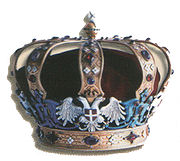
Coat of arms of the Kingdom of Yugoslavia
Encyclopedia


Coat of arms
A coat of arms is a unique heraldic design on a shield or escutcheon or on a surcoat or tabard used to cover and protect armour and to identify the wearer. Thus the term is often stated as "coat-armour", because it was anciently displayed on the front of a coat of cloth...
of the Kingdom of Yugoslavia
Kingdom of Yugoslavia
The Kingdom of Yugoslavia was a state stretching from the Western Balkans to Central Europe which existed during the often-tumultuous interwar era of 1918–1941...
(previously called Kingdom of Serbs, Croats and Slovenes) was an evolution of the Coat of arms of Serbia
Coat of arms of Serbia
The coat of arms of Serbia is based the family arms of the former Obrenović dynasty and features the white bicephalic eagle of the Nemanjić dynasty. An ermine cape of the style once worn by kings is featured in the background. The double-headed eagle has been used since Byzantine era, the Serbian...
. Graphically the coat of arms were similar, featuring only two major differences.
The first difference being the royal crowns, The royal Serbian coat of arms depicts the Obrenović
House of Obrenovic
The House of Obrenović was a Serbian dynasty that ruled Serbia from 1815 to 1842, and again from 1858 to 1903. They came to power through the leadership of their progenitor Miloš Obrenović in the Second Serbian uprising against the Ottoman Empire, which led to the formation of the Principality of...
dynastic crown. While the royal Yugoslav coat of arms depicted the ruling Karađorđević dynastic crown.
The second difference was the shield surmounted on the white double headed eagle. The previous Serbian coat of arms
Coat of arms of Serbia
The coat of arms of Serbia is based the family arms of the former Obrenović dynasty and features the white bicephalic eagle of the Nemanjić dynasty. An ermine cape of the style once worn by kings is featured in the background. The double-headed eagle has been used since Byzantine era, the Serbian...
depicted only the Serbian tetragrammatic cross
Serbian cross
The Serbian Cross is a national symbol of Serbia, part of the Coat of Arms of Serbia, and the flag of Serbia. It is composed of a cross symbol with four C-shapes on each of its corners, in use as a national emblem since the 14th century....
, representing only the Serbian
Serbs
The Serbs are a South Slavic ethnic group of the Balkans and southern Central Europe. Serbs are located mainly in Serbia, Montenegro and Bosnia and Herzegovina, and form a sizable minority in Croatia, the Republic of Macedonia and Slovenia. Likewise, Serbs are an officially recognized minority in...
nation. When Yugoslavia was formed, the surmounted shield was altered to include the newly integrated Croat
Croats
Croats are a South Slavic ethnic group mostly living in Croatia, Bosnia and Herzegovina and nearby countries. There are around 4 million Croats living inside Croatia and up to 4.5 million throughout the rest of the world. Responding to political, social and economic pressure, many Croats have...
and Slovene nations, as the three official nations of Yugoslavia.
An image of the royal Yugoslav coat of arms can be seen on the 10-Yugoslav dinar
Yugoslav dinar
The dinar was the currency of the three Yugoslav states: the Kingdom of Yugoslavia , the Socialist Federal Republic of Yugoslavia and the Federal Republic of Yugoslavia between 1918 and 2003. The dinar was subdivided into 100 para...
banknote of 1926.

